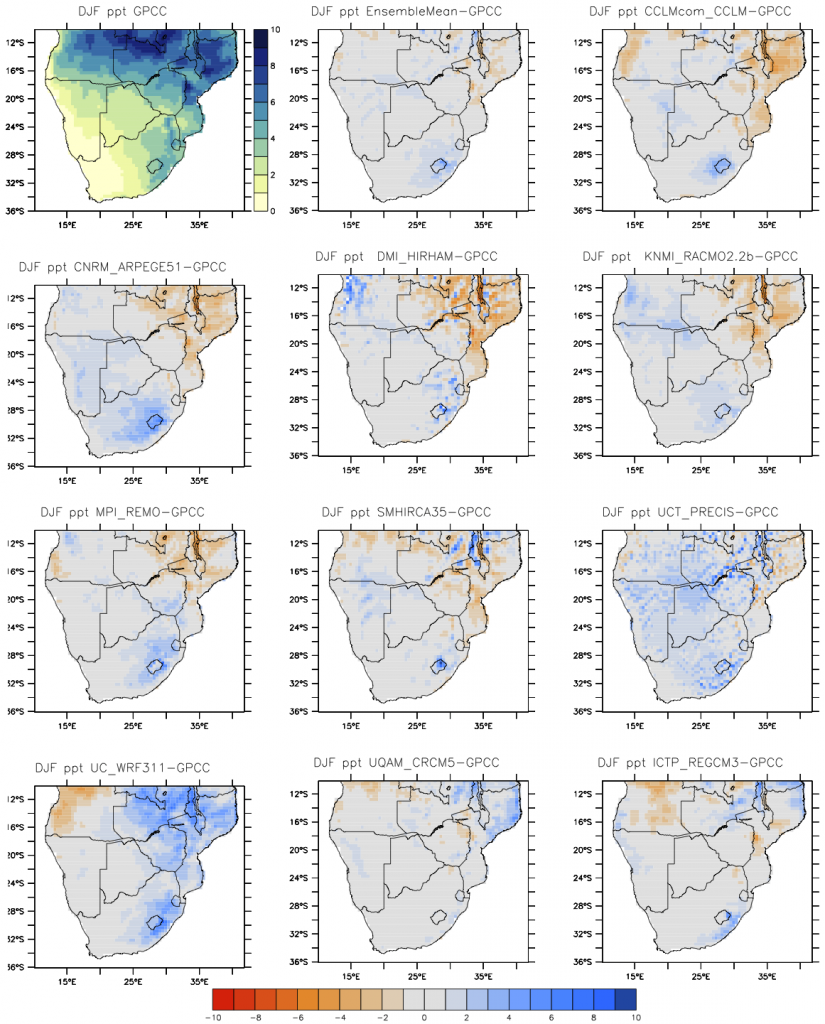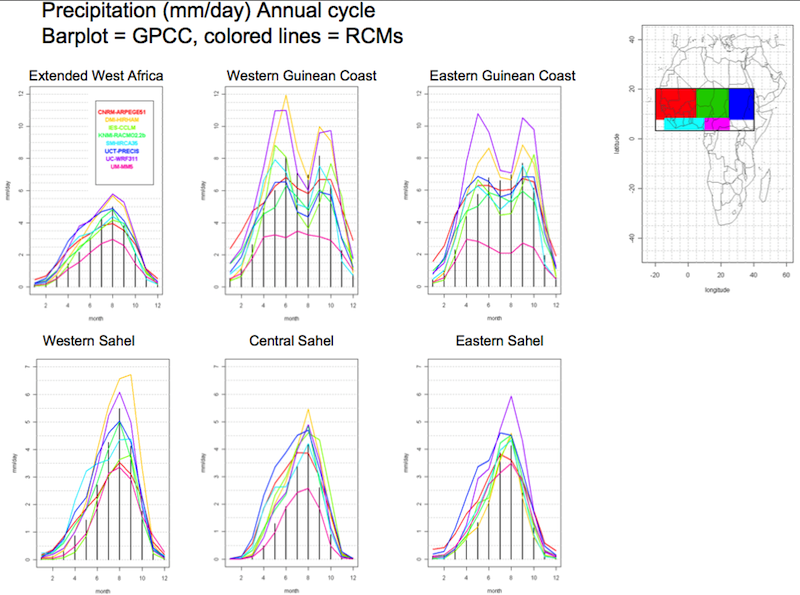The CORDEX Africa Analysis Campaign
CORDEX is producing high resolution climate data of an identical resolution over specified regional domains using forcing data from either analyses of observations (1988-2010) or from global climate models (1950-2100). This downscaling is performed using multiple regional climate models (RCMs) as well as statistical downscaling (SD) techniques. An ensemble of simulations are produced which will be analysed to further understand atmospheric processes over Africa, how these may change into the future as well as the impacts these changes may have in many regions of the continent. Specific sets of analysis metrics for both model validation and assessment of projections are being developed for each region. A number of RCM groups worldwide have joined the CORDEX effort, and the first reanalysis (1988-2009) simulations have been completed for the Africa domain (Figure 1 below) as well as for other regional domains.
The CORDEX Africa Analysis campaign is designed around the following ethos:
A – Analysis; Developing methods and tools to analyse atmospheric processes over Africa and how these may change into the future
F – Foci; Addressing key meteorological and impacts knowledge gaps
R – Regional messages; Presenting information for key regions in the continent
I – Integrated approach; Bringing together climate and vulnerability-impact-adaptation scientists to identify and address key climate vulnerabilities
C – Capacity development; Long-term collaboration between African scientists and key global institutions for career development
A – Application and Adaptation; Bridging the science-society divide through transforming climate data to actionable information
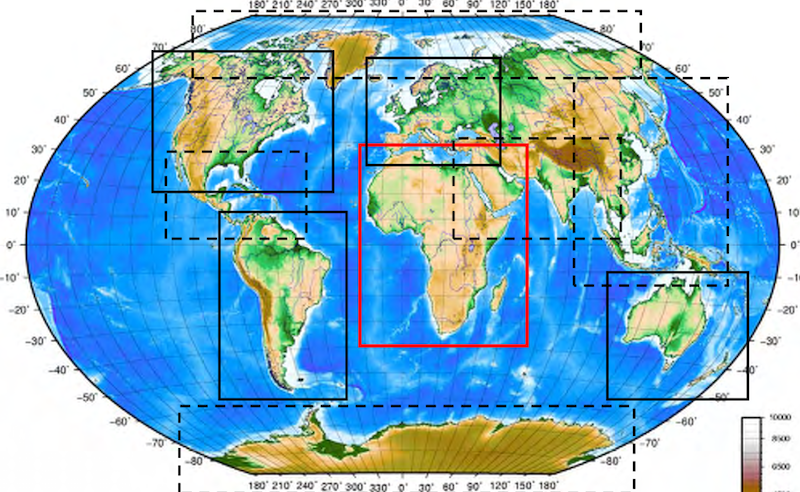
The African domain is a region of special focus and to this end three training workshops have organised by the WCRP, the Climate Systems Analysis Group at the University of Cape Town in South Africa and START (the global change system for analysis and training). At these workshops, African scientists in both core climate and vulnerability-impacts-adaptation (VIA) disciplines have been brought together to analyse the CORDEX data over the continent. The first workshop was held in Trieste, Italy on the 25-26 March 2011 and focused on introducing delegates to analysis techniques as well as forming regional groupings which will carry out the analysis for their respective geographical locations. A follow-up, more comprehensive analysis workshop will be help in Cape Town, South Africa from 21-25 November 2011 once GCM data becomes available for downscaling. A third workshop will focus on writing up the analysis results for journal articles early in 2012.
The first Cordex Africa Analysis workshop was held at the International Centre for Theoretical Physics in Trieste, Italy on the 25th and 26th March 2011, directly following the 4-day International Conference on the Coordinated Regional Climate Downscaling Experiment. There were 27 participants from across Africa, representing a mix of scientists from the atmospheric science and climate impact communities.
This was the first of a planned series of three workshops with the aim of leveraging data output from the CORDEX activities for benefit in regional climate change adaptation and decision-making. The primary goal was to analyse data from the CORDEX simulations over the African domain from the ERA Interim reanalysis to better understand the regional details of climate processes. The first workshop is focused on basic skill development among the participants from Africa, in order to better prepare them for analysis of CORDEX results that will take place in the second workshop, and on developing the regional research questions to direct the subsequent analysis activities.
The workshop engaged African climate scientists and impacts modellers to form sub-regional groupings to undertake the relevant analyses. Specific foci were to work with analysis tools using initial regional climate model output of the recent past, emphasizing initially the inter-annual, annual and seasonal time scales. Participants formed four geographical regions representing their interests, namely the Sahel, southern West Africa south, East Africa, and southern Africa regions. Each group were introduced to the analysis tools and applied these to the supplied data from their regions.
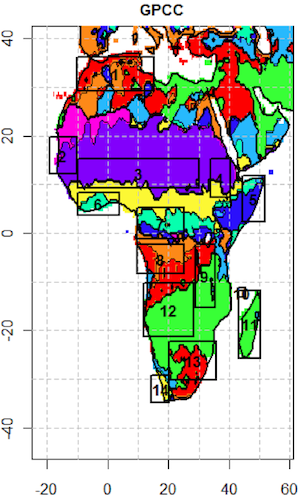 |
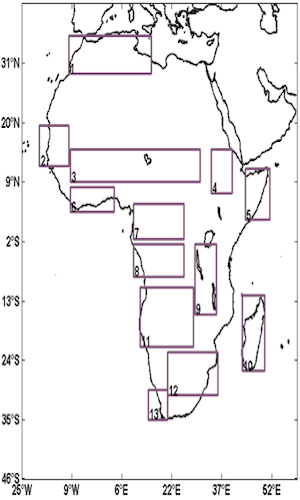 |
Regions of homogeneous rainfall characteristics as identified in the GPCC rainfall product (see Favre et al., 2011)
A wiki site was set up to co-ordinate activities which is still active ans used as the primary method of communication and is the repository for posting results so they can be accessed by all members of the groups.
A second, smaller meeting which included only the group leaders was held at the Climate Systems Analysis Group at the University of Cape Town in the first week of July 2011 as a follow-up action to the ICTP workshop in Trieste. The main purpose of this second workshop was to engage the group leaders in further developing analytical pathways and interpretive skills related to CORDEX Africa Analysis campaign. A number of knowledge gaps were identified for each region and based on these analysis goals were defined and implemented. These included amongst others investigations of model biases based on the ERA Interim reanalysis (see Figure 2 below), discussions of how to identify regional rainfall onset (given different definitions of onset), relating temperature and rainfall results to the driving circulations and the assessment of the model ability to capture regional atmospheric phenomena such as jets, tropical cyclones etc.
The second CORDEX Africa Analysis workshop was held at the Climate Systems Analysis Group, University of Cape Town from 21-25 November 2011. This workshop is had three main goals. The first was to finalize the analyses of the ERA Interim data and then begin the analysis of at least one downscaled GCM 150 year simulation (1951-2100). The second to continue the training of climate scientists using the CORDEX data. The third to create an analysis space that integrates work of climate scientists as well as vulnerability-impact-adaptation (VIA) scientists. The first two aims were accomplished however the integration of the VIA component proved difficult as only 3 of the 9 invited VIA specialists attended the meeting.
A final workshop was held in February 2012 to write up the results from the previous workshops so that they could be considered in the IPCC 5th Assessment Report. This is an initial major goal of the project as in the IPCC 4th Assessment Report there was a dearth of information concerning African climate, how it may change as well as the impact and adaptation strategies. From this workshop 6 potential papers emerged and are in the final internal review stages before being submitted to selected journals.
For any other information about the CORDEX Africa Analysis campaign please contact Chris Lennard at lennard@csag.uct.ac.za.

